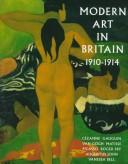| Listing 1 - 10 of 264 | << page >> |
Sort by
|
Book
Year: 1964 Publisher: Harmondsworth : Penguin books,
Abstract | Keywords | Export | Availability | Bookmark
 Loading...
Loading...Choose an application
- Reference Manager
- EndNote
- RefWorks (Direct export to RefWorks)
Book
Year: 1954 Publisher: Harmondsworth : Penguin books,
Abstract | Keywords | Export | Availability | Bookmark
 Loading...
Loading...Choose an application
- Reference Manager
- EndNote
- RefWorks (Direct export to RefWorks)
Book
ISBN: 0140210237 Year: 1969 Publisher: Harmondsworth : Penguin,
Abstract | Keywords | Export | Availability | Bookmark
 Loading...
Loading...Choose an application
- Reference Manager
- EndNote
- RefWorks (Direct export to RefWorks)
Book
ISBN: 9781861543141 Year: 2010 Publisher: London Booth-Clibborn
Abstract | Keywords | Export | Availability | Bookmark
 Loading...
Loading...Choose an application
- Reference Manager
- EndNote
- RefWorks (Direct export to RefWorks)

ISBN: 185894032X 9781858940328 Year: 1997 Publisher: London: Merrell Holberton,
Abstract | Keywords | Export | Availability | Bookmark
 Loading...
Loading...Choose an application
- Reference Manager
- EndNote
- RefWorks (Direct export to RefWorks)
Art, British --- Art, British --- Art, European
Book
Year: 1982 Publisher: Tōkyō : Asahi Shinbunsha,
Abstract | Keywords | Export | Availability | Bookmark
 Loading...
Loading...Choose an application
- Reference Manager
- EndNote
- RefWorks (Direct export to RefWorks)
Art, British --- Art, British --- Art britannique
Book
ISBN: 089207020X Year: 1979 Publisher: New York Solomon R. Guggenheim Foundation
Abstract | Keywords | Export | Availability | Bookmark
 Loading...
Loading...Choose an application
- Reference Manager
- EndNote
- RefWorks (Direct export to RefWorks)
Art, British --- E-books
Book
ISBN: 9781783109241 1783109246 1306922712 9781306922715 9781780423388 1780423381 9781783103447 1783103442 1783109092 Year: 2014 Publisher: New York Parkstone International
Abstract | Keywords | Export | Availability | Bookmark
 Loading...
Loading...Choose an application
- Reference Manager
- EndNote
- RefWorks (Direct export to RefWorks)
Book
ISBN: 1107448794 1108074197 Year: 1836 Publisher: Place of publication not identified : Cambridge : publisher not identified, Cambridge University Press
Abstract | Keywords | Export | Availability | Bookmark
 Loading...
Loading...Choose an application
- Reference Manager
- EndNote
- RefWorks (Direct export to RefWorks)
The German artist Johann David Passavant (1787-1861) visited Britain in 1831 in order to examine works by Raphael in private and public galleries for a book he was preparing. He had not been able to find any helpful German accounts of British collections, and so decided to publish a narrative of his own travels and observations. The British writer and art critic Elizabeth Rigby (later Lady Eastlake) produced a two-volume translation in 1836, believing that English readers would benefit from Passavant's descriptions of little-known collections in their own country, as well as from his practitioner's response to the works themselves. Volume 2 begins with the duke of Marlborough's collection at Blenheim, and continues to cover Chatsworth, Althorpe, Holkham, and other 'country seats', finishing in Cambridge. Passavant also provides a catalogue of drawings at Buckingham Palace, a list of the pictures discussed, and an overview of collections not visited.
Art, British --- Art
Book
ISBN: 135029179X 9781350009257 9781350291799 1350009253 Year: 2022 Publisher: London: New York: Bloomsbury Academic,
Abstract | Keywords | Export | Availability | Bookmark
 Loading...
Loading...Choose an application
- Reference Manager
- EndNote
- RefWorks (Direct export to RefWorks)
"What is the future of conceptualism? What expressions can it take in the 21st century? Is there a new role for aesthetic experience in art and, if so, what is that role exactly? Aesthetics, Philosophy and Martin Creed uses one of this generation's most important and influential artists to address themes crucial to contemporary aesthetics. Working in an impressive variety of artistic media, Creed represents a strikingly innovative take on conceptualism. Through his ingenious and thought-provoking work, a team of international philosophers, jurists and art historians illustrate how Creed epitomizes several questions central to philosophical aesthetics today and provides a glimpse of the future both of art and aesthetic discourse. They discuss key concepts for Creed's work, including immediacy (in his photographs of smiling people), compositional order (in his geometric paintings), simplicity (in Work No. 218, a sheet paper crumpled into a ball) and shamelessness (in his videos of vomiting people). By bringing a working artist into the heart of academic discussions, Aesthetics, Philosophy and Martin Creed highlights the relevance of philosophical discussions of art to understanding art today"--
| Listing 1 - 10 of 264 | << page >> |
Sort by
|

 Search
Search Feedback
Feedback About UniCat
About UniCat  Help
Help News
News